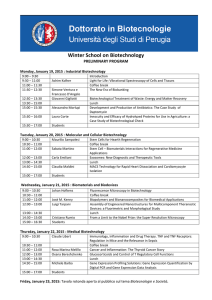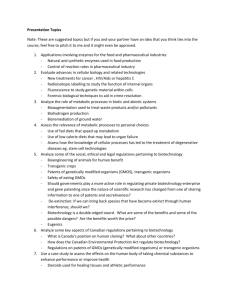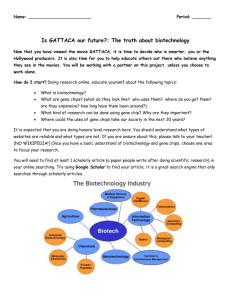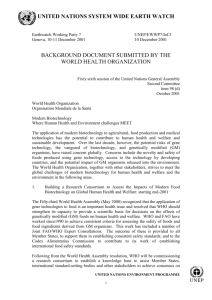21 Biotechnology Stu..
advertisement
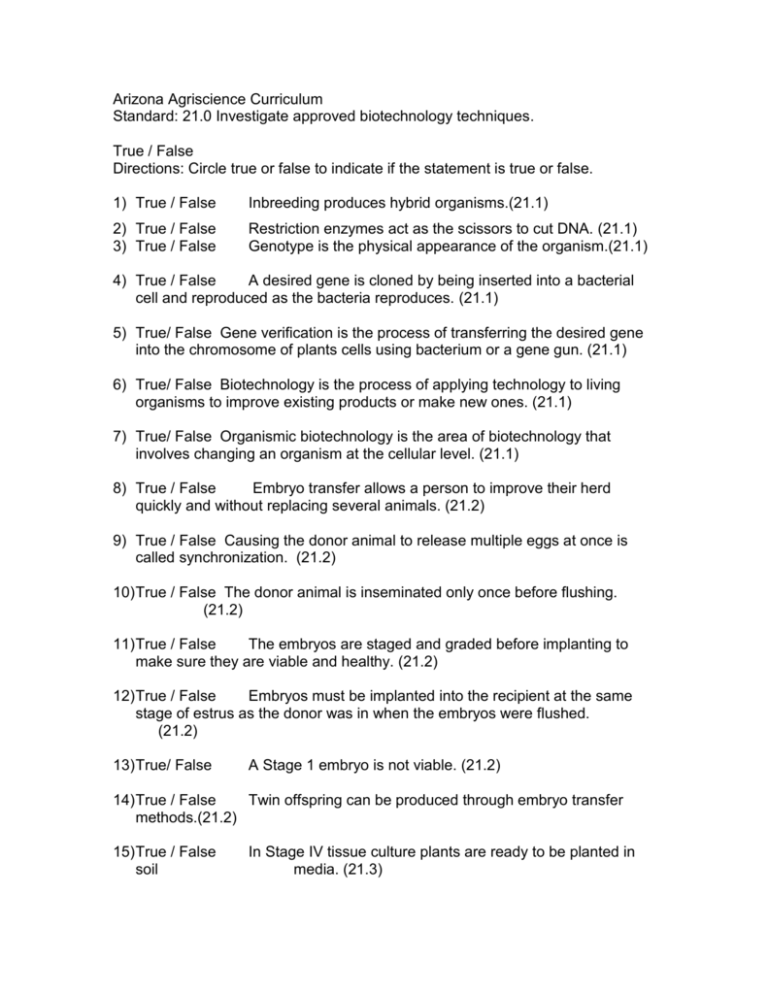
Arizona Agriscience Curriculum Standard: 21.0 Investigate approved biotechnology techniques. True / False Directions: Circle true or false to indicate if the statement is true or false. 1) True / False Inbreeding produces hybrid organisms.(21.1) 2) True / False 3) True / False Restriction enzymes act as the scissors to cut DNA. (21.1) Genotype is the physical appearance of the organism.(21.1) 4) True / False A desired gene is cloned by being inserted into a bacterial cell and reproduced as the bacteria reproduces. (21.1) 5) True/ False Gene verification is the process of transferring the desired gene into the chromosome of plants cells using bacterium or a gene gun. (21.1) 6) True/ False Biotechnology is the process of applying technology to living organisms to improve existing products or make new ones. (21.1) 7) True/ False Organismic biotechnology is the area of biotechnology that involves changing an organism at the cellular level. (21.1) 8) True / False Embryo transfer allows a person to improve their herd quickly and without replacing several animals. (21.2) 9) True / False Causing the donor animal to release multiple eggs at once is called synchronization. (21.2) 10) True / False The donor animal is inseminated only once before flushing. (21.2) 11) True / False The embryos are staged and graded before implanting to make sure they are viable and healthy. (21.2) 12) True / False Embryos must be implanted into the recipient at the same stage of estrus as the donor was in when the embryos were flushed. (21.2) 13) True/ False A Stage 1 embryo is not viable. (21.2) 14) True / False Twin offspring can be produced through embryo transfer methods.(21.2) 15) True / False soil In Stage IV tissue culture plants are ready to be planted in media. (21.3) 16) True / False Plants in culture perform little or no photosynthesis. (21.3) 17) True / False Cultured plants are used to growing in low humidity. (21.3) 18) True / False Plants must be acclimated to low humidity gradually. (21.3) 19) True / False When sterilizing the plant material during Stage I, keep the stems in the bleach solution longer than 20 minutes. (21.3) 20) True / False Aseptic technique must be followed when conducting tissue culture activities. (21.3) 21) True / False Rooting media will stunt root growth of tissue cultures. (21.3) 22) True / False Through biotechnology, garlic can reduce cholesterol. (21.4) 23) True / False “Golden rice”, a biotech product can help prevent blindness in developing nations. (21.4) 24) True / False The American Medical Association is against further biotechnology research and advancements. (21.4) 25) True / False Biotechnology is the #1 Consumer Food Safety Concern. (21.4) 26) True / False Increased pesticide use is a negative result of biotechnology. (21.4) 27) True / False Hormones play a central role in the growth and development of plants. (21.6) 28) True / False Gibberellins affect fruit ripening.(21.6) 29) True / False Synthetic plant hormones are used to manipulate plant growth and development. (21.6) 30) True / False If you wanted to manipulate the size of fruit you would use Gibberellins.(21.6) 31) True / False Auxins inhibit cell growth. (21.6) 32) True/ False Bits of DNA with no function, merely the peculiar ability to spread themselves around by hopping in and out of DNA are called transposable genes. (21.8) 33) True / False A Biochemist’s main role is to study the molecular nature of the gene and its mechanisms of gene replication, mutation, and expression.(21.9) 34) True / False Research Scientists design, plan and investigate experiments and fieldwork to advance and apply knowledge of biological and natural phenomena. (21.9) 35) True / False Disease, insect and drought resistance, are all ways biotechnology can improve plants.(21.11) 36) True / False The benefits of adding genes to plants to control diseases is that it's much faster to grow a crop.(21.11) Multiple Choice Directions: Circle the letter that corresponds with the correct answer. 37) Which process is used to insert a transgene when it is important to target gene sequences to specific sites in the genome? (21.1) a) microinjection b) embryonic stem cell transfer c) retroviral vectors d) nuclear transfer 38) A ____________________, obtained by gel electrophoresis, can be used for identification.(21.1) a. DNA fingerprint b. hair stand c. blood sample d. cell 39) The genetic makeup of an organism that can also be adapted by the environmental conditions.(21.1) a) Phenotype b) Genotype c) Genetic design d) None of the above 40) What is used to put DNA back together?(21.1) a. b. c. d. restriction enzymes ligase base chromosome 41) The study of genes and heredity, or how characteristics are passed from parents to children.(21.1) a) Biology b) Heredity c) Genetics d) Genealogy 42) The process of cutting the DNA of a gene in order to add base pairs.(21.1) a) Genetic engineering b) Gene Splicing c) Both A and B d) None of the above 43) When genetically modifying animals, how many generations does it take before the offspring will have a stable form of the inserted gene? (21.1) a) b) c) d) 4 2 3 5 44) What is the mechanism used to clone a desired plant gene? (21.1) a) b) c) d) Virus Bacterial cell Gene Gun Gene Splicer 45) What is the process by which researchers produce an entire plant from cells that contain the new gene? (21.1) a. b. c. d. Gene Cloning Gene Implementation Gene Verification Cell Regeneration 46) What must happen after plants have been created with new genes and before seeds can be produced? (21.1) a. b. c. d. Gene Verification Cell regeneration Trait Identification Testing of the new plant 47) Which embryo stages can be used in the transfer process? (21.2) a) stages 1-5 b) stages 3-8 c) stages 4-7 d) stages 6-9 48) What technique allows you to use the oldest, ugliest, cheapest female animal to produce an unrelated and higher producing offspring? (21.2) a) b) c) d) Selective breeding Embryo transfer Gene cloning Artificial insemination 49) The process of Donor animals being injected with FSH causing the release of multiple eggs in a single estrus cycle. (21.2) a) Super-ovulation b) Flushing c) Insemination d) Synchronization 50) How often must a donor animal be inseminated to insure multiple embryos? (21.2) a) Every 6 hours b) Every 12 hours c) Every 8 hours d) Every 16 hours 51) Why is estrus synchronization important between the donor and recipient animals during embryo transfer? (21.2) a) Easier embryo flushing b) Increased pregnancy rate c) Increased embryo production d) Synchronized births 52) If you wanted to increase the quality of your herd and you only had commercial grade cows, which process would allow you to upgrade your herd to pedigreed stock the quickest? (21.2) a) Artificial insemination b) Embryo transfer c) Breeding a purebred bull to your females d) None of the above 53) During Stage I tissue culture, it is imperative that you follow: (21.3) a) proper aseptic technique b) ex plants have one node c) all tools and equipment are cleaned up d) all of the above 54) How often should shoots be divided in Stage II tissue culture (21.3) a) 10 weeks b) 2 weeks c) 4 weeks d) 6 weeks 55) Stage II tissue culture involves more shoot multiplication and (21.3) a) axillary bud formation b) ex plant production c) formation of leaves d) formation of stems 56) Stage III tissue culture characteristics include development of (21.3) a) stems b) leaves c) roots d) buds 57) Moving to rooting media will _____________ root growth? (21.3) a) stunt b) enhance c) have no effect d) hasten 58) Why is it important to remove all dirt and debris from the plant material when doing tissue culture? (21.3) a. Dirt and debris will contaminate the entire procedure b. It will prevent Photosynthesis fro taking place. c. It is important to keep a clean lab area. d. The dirt and debris will affect the nutrient content of the growing media. 59) What was the first commercial biotech product? (21.4) a) Corn for ethanol b) Insulin c) Enriched rice d) Disease resistant plants 60) What was the first commercially produced biotech food product?(21.4) a) FlavorSavor Tomatoes b) Chymosin and enzyme for making cheese c) Bananas with a longer shelf life d) Sweet peppers 61) How have some bananas been altered to improve our health?(21.4) a) b) c) d) Higher protein content Contain insulin Edible hepatitis vaccine Increased iron content 62) What is an environmental benefit of biotechnology?(21.4) a) Reduced pesticide use b) Lower energy requirements c) Cleaner Water d) All of the above 63) How has biotechnology affected the health benefits of rice?(21.4) a) Increased iron content b) Enriched with beta-carotene c) Lower in cholesterol d) Both a and c 64) What is the practice of crop breeding that involves the controlled pollination of plants? (21.5) a. b. c. d. Selective breeding Improvement by selection Molecular biotechnology Hybridization 65) What is the process by which livestock are bred to obtain desired characteristics in the offspring? (21.5) a. b. c. d. Selective breeding Improvement by selection Molecular biotechnology Hybridization 66) What is the are of biotechnology that seeks to promote healthier and more productive organisms? (21.5) (a) Improvement by selection (b) Molecular biotechnology (c) Hybridization (d) Organismic biotechnology 67) This hormone affects fruit development and ripening.(21.6) a) Auxin b) Cytokinins c) Gibberellins d) Abscisic acid e) Ethylene 68) What is not a use of the synthetic form of the plant hormone Gibberellins?(21.6) a) Increase size of seedless grapes b) Improve length, crispness of celery stalks c) Regulate flowering response d) As a herbicide to cause weeds to "grow to death." 69) What plant hormone’s synthetic form is used to prevent flowers from drying? (21.6) a) Auxin b) Cytokinins c) Gibberellins d) Abscisic acid e) Ethylene 70) What plant hormone inhibits cell growth?(21.6) a) Auxin b) Cytokinins c) Gibberellins d) Abscisic acid e) Ethylene 71) A physician trained to prevent, diagnose, manage, and treat a disease is known as a(n): (21.9) a. immunologist b. enzymologist c. biochemist d. molecular biologist 72) A patent lawyer is involved in which area of biotechnology? (21.9) a. Research b. Development c. Production d. Management & Marketing 73) A chemical engineer is involved in which area of biotechnology? (21.9) a. Research b. Development c. Production d. Management & Marketing 74) Conducts clinical laboratory testing that is crucial to detecting and diagnosing diseases. (21.9) a) Research Scientist b) Laboratory Technician c) Sales account representative d) Patent Lawyer 75) A ________________ is concerned with transforming raw materials into valuable products by chemical, biochemical or physical processes.(21.9) a) Biochemist b) Chemical Engineer c) Molecular Biologist d) Program Manager 76) What biotechnology career would you consider if you wanted to be involved in research, development, and production? (21.9) a) Research Scientist b) Laboratory Technician c) Sales account representative d) Patent Lawyer 77) Of the following, circle the answer that is not a negative aspect of biotechnology: a. developing countries can't afford it b. there's concern that the synthetic products are bad for you c. food is sometime better tasting d. many products aren't labeled 78) Why has the Bacillus Thuringenesis gene been used to modify agriculture crops?(21.11) a) To prevent disease b) To create pest resistance c) To increase the yield d) To increase the growth rate Matching Directions: Correctly match each term with its description and write the corresponding letter on the line provided. (21.1) 79) ______ Microinjection a. Using the cloning technique to produce transgenic animals. 80) ______ Retroviral Vectors b. Fertilizing harvested eggs in-vitro 81) ______ Nuclear Transfer 82) ______ Embryonic Stem Cell Transfer c. Results in random placement of gene into the genome and differing offspring d. Used to target gene sequences to specific sites in the genome (21.3) 83) aseptic technique A. plant your are using for tissue culture 84) Node B. items that make materials impure of unclean by contact or mixture C. The points on a stem where a leaf is attached. D. Free of pathogenic microorganisms 85) Contaminates 86) semi-herbaceous 87) ex-plant E. Transition part of the plant between woody and non-woody growth F. A substitute for soil in tissue culture that provides the plants with nutrients, moisture and a place for the roots to anchor the plant. 88) growing media Match the biotechnology advancement with the associated product (21.4) 89) ____ Potatoes 90) ____ Tomatoes 91) ____ Fruits and vegetables 92) ____ Rice a. Enriched with beta-carotene and iron content. b. Slower ripening time and increased nutrient value c. increased antioxidants d. Increased solid content to prevent oils from saturating. Identify the diagram that illustrates each of the embryo stages below. (21.2) 93) _____ Stage 4 Morula A. 94) _____ Stage 5 Blastocyst B. 95) _____ Stage 6 Expanding Blastocyst C. 96) _____ Two Cell D. (21.6) Match the description to the appropriate plant hormone. 97) ____Auxins A. Used as spray for shrubs and trees to induce dormancy for shipping in nursery industry 98) _____ Cytokinins B. Produced naturally by ripened fruit, germinating seeds, decaying flowers C. Increases fruit size 99) _____ Gibberellins 100) _____ Abscisic Acid 101) _____ Ethylene D. Naturally found in developing tissues E. Used in nurseries to: induce root formation and to promote uniform flowering Short Answer 102) Identify four benefits of food production caused by biotechnology. (21.4) 103) Identify one specific biotechnology breakthrough and discuss why it is important or interesting. (21.11) 104) Identify two environmental benefits caused by biotechnology. (21.4) 105) Name 2 benefits of embryo transfer. (21.5) 106) Name three criteria for selecting donor animals. (21.2) On May 8th in the morning the onset of estrus began for the donor cow. The donor cow was bred 12 hours after the onset of estrus. The donor was flushed 7 days after breeding. The embryos were frozen. (21.2) 107) a) b) c) d) On what date was the donor flushed and the embryos frozen? May 15 pm May 15 am May 16 am May 14 pm 108) Between what dates should the embryo be transferred into the recipient cow if she was in heat (started estrus) on October 12th in the morning? a) Oct. 19 am b) Oct. 19 pm c) Oct. 20 am d) Oct. 20 pm



